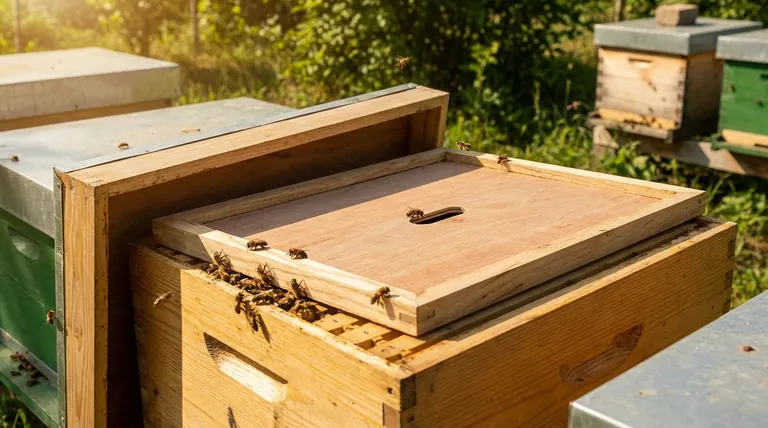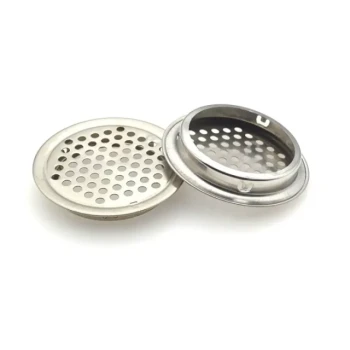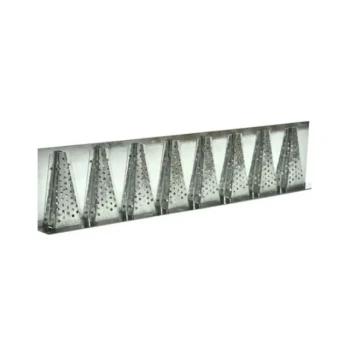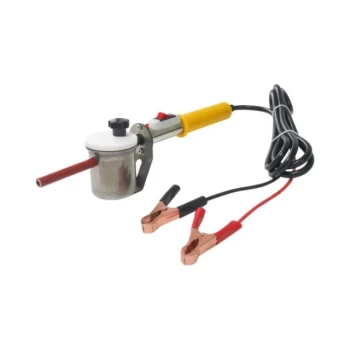In essence, the inner cover serves as a critical interface between the colony's living space and the harshness of the outside world. It is a thin wooden board placed directly on top of the uppermost hive box, sitting just beneath the main outer roof. Its primary functions are to provide insulation, control ventilation, and prevent the bees from sealing the hive shut, which dramatically simplifies hive management.
The inner cover is more than just a secondary lid; it is a strategic tool for hive management. Its primary value lies in creating a buffer zone that helps regulate temperature and moisture, while also making hive inspections far less disruptive for both the beekeeper and the bees.

The Core Functions of the Inner Cover
The inner cover is deceptively simple, yet it performs several crucial roles that contribute directly to the health and productivity of the colony.
Facilitating Easier Hive Inspections
Bees use a resinous substance called propolis to seal every crack and gap inside their hive. Without an inner cover, they would firmly glue the outer telescoping cover directly to the top hive box.
This would make opening the hive an aggressive, disruptive process requiring significant force with a hive tool. The inner cover provides a lightweight, easily removable barrier that you can gently pry off, allowing for much calmer and more controlled inspections.
Providing Critical Insulation
The space between the inner cover and the outer cover creates a pocket of dead air. This trapped air is a poor conductor of heat and acts as a powerful insulator, much like a double-pane window.
In the summer, this air space buffers the colony from the intense heat of direct sunlight on the outer cover. In the winter, it helps reduce the loss of precious heat generated by the winter cluster.
Managing Ventilation and Moisture
Proper airflow is vital for a colony. The inner cover typically features a notched rim and a central hole, both of which aid in ventilation.
The notch can serve as an upper entrance for the bees, which helps reduce congestion at the main entrance and provides an escape route for heat and humidity during summer.
In winter, warm, moist air from the bees' respiration rises. The inner cover prevents this moisture-laden air from hitting the cold surface of the outer cover, where it would condense and drip back down onto the cluster. Instead, it can escape through the upper ventilation points.
Creating a Utility Port
The central hole in the inner cover is not just for ventilation; it is a key access point for in-hive feeders.
Beekeepers can place a jar of syrup upside down over this hole, allowing them to feed the colony directly inside the hive. This method is protected from weather and prevents robbing from other bees.
Understanding the Trade-offs
While essential, the features of the inner cover must be managed correctly according to the season and your climate.
The Notched Rim: Entrance vs. Draft
The upper entrance created by the notch is beneficial in summer but can create an unwanted draft in winter, leading to heat loss.
For this reason, many inner covers are designed with a shallow side and a deep side. Placing the deep side down creates the ventilation gap, while flipping it to the shallow side down closes it off for winter.
The Central Hole: Access vs. Heat Loss
While perfect for a feeder, an open central hole can be a major point of heat loss during the winter when you are not feeding.
It is common practice for beekeepers to cover this hole during winter with a small piece of wood, tape, or by placing insulation material directly on top of the inner cover.
How to Use Your Inner Cover Effectively
Your approach to the inner cover should change with the seasons and your management goals.
- If your primary focus is summer nectar collection: Ensure the inner cover's notch provides an upper entrance for ventilation and to ease traffic congestion.
- If your primary focus is winter survival: Flip the inner cover to close the top entrance notch and place insulation (like a foam board or quilt box) directly on top of it to manage moisture and retain heat.
- If your primary focus is feeding a new colony: Use the central hole as the access point for an inverted jar feeder, ensuring it's protected by an empty hive box and the outer cover.
Ultimately, mastering the simple inner cover is a key step toward becoming a more effective and observant beekeeper.
Summary Table:
| Function | Key Benefit |
|---|---|
| Easier Hive Inspections | Prevents bees from sealing the hive shut with propolis. |
| Insulation | Creates a dead air space to buffer against summer heat and winter cold. |
| Ventilation & Moisture Control | Manages airflow and prevents condensation with a notched rim and central hole. |
| Utility Port | Provides access for in-hive feeders, protecting them from weather and robbers. |
Ready to optimize your apiary with professional-grade equipment?
As a trusted wholesale supplier to commercial apiaries and distributors, HONESTBEE provides the durable, well-designed inner covers and hive components your operation needs for superior colony health and efficient management.
Contact our expert team today to discuss your wholesale requirements and discover how our beekeeping supplies can contribute to your success.
Visual Guide

Related Products
- Inner Beehive Cover for Beekeeping Bee Hive Inner Cover
- Professional Insulated Winter Hive Wrap for Beekeeping
- Stainless Steel Round Beehive Air Vents for Ventilation
- Professional Hive Top Bee Feeder for Beekeeping
- In-Hive Dual Compartment Frame Bee Feeder for Targeted Colony Nutrition
People Also Ask
- What is the function of the center hole in the inner cover? Master Hive Ventilation and Feeding
- How is the inner cover used to promote ventilation? Master Hive Climate Control for Healthy Bees
- What is the function of an inner cover in a beehive? Essential for Hive Health & Management
- What are the advantages of using an inner cover in a beehive? Key Benefits for Hive Health & Beekeeper Efficiency
- What is the recommended orientation for the rim of an inner cover? Master Hive Ventilation and Insulation



















